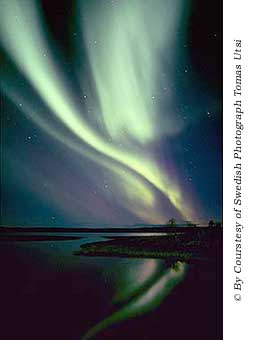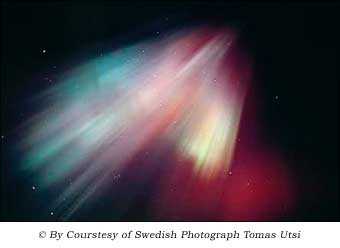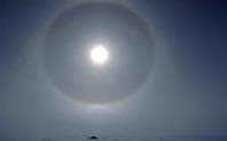|
  
|
 |
|
 Antarctic
Polar Regions Antarctic
Polar Regions
Aurora Borealis and other Phenomena

Midnight sun
In a matter of weeks, the endlessly trying polar night is nothing but a memory. Daylight dominates the sky increasingly until it ends up monopolising 24 hours of every day. It is time for the sumptuous midnight sun to appear. Because from now on, the only "nocturnal" alternative the blinding light of day has to offer is a few hours of soft light, a warm atmosphere and long shadows. How long does it last? It all depends. Like the polar night (see below), it is a phenomenon that declines with the latitudes. It only lasts for 48 hours at the Arctic Circle, whereas it lasts for almost 6 months in the immediate vicinity of the North Pole. Between these two extremes, the period of the midnight sun varies according to where you are...
Mirages
Summer is also the season for mirages. Mirages are images that appear to be projected into the sky and can also be seen in multiples or appear upside down. The most spectacular mirages are called Fata Morgana. They can be like discovering an unknown land, a mysterious city, a ghost ship or an uncharted range of mountains.
In fact, the mirages we see are caused by contact between a mass of hot air and a stretch of cold water. As a result, the light is distorted, which is further intensified by the presence of ice crystals suspended in the atmosphere.
Some mirages have left their mark on the history of the polar regions. Crocker Land, glimpsed several times by Robert Peary or the mountain ranges that prevented John Ross from leaving Lancaster Sound, are examples of mirages that subsequently turned out to be entirely in the imagination.
 Polar night
Polar night
Already the grey days of the very brief autumn are here. The return of the long, long winter is imminent. Soon, the black cloak of darkness will cover a landscape lit only by the moon and the stars. This is the polar night.
This period is made all the more difficult as the fragility of the first ice ties the nomad down to a sedendary existence. Depression is never far away. More fragile souls will not come out of it unaffacted. Some will even succumb to an acute form of polar hysteria, an afflication well known among the indigenous population. The Esquimaux in Greenland call it "amok" hence the English term "to run amok". White out and white light
When the winter is in full swing, it is easy to be blinded by the intensity of the light, even to be anaesthetised by an atmosphere like cotton wool.
Worse still, light reflected by the ground covered evenly with snow and the diffuse light filtered by the cloud cover can create "white out" conditions, or snow blindness, which makes it impossible to see any relief in the terrain, meaning you cannot venture out over ground that is even slightly hilly.
When that happens, it is only a short step to "white light". The snow and fog combine to obliterate shadows and markings so that vertical and horizontal vanishing points no longer exist. The result is a loss of balance that makes all progress hazardous and a risk to life and limb.
Aurora borealis
Winter is also the best season to observe aurora borealis - the northern lights. This phenomenon certainly occurs in summer, but the contsant daylight prevents it from being seen. At night, on the other hand, what a light show! A curtain of undulating lines in delicate colours illuminates the vast whitish expanse of of sky with a diaphanous, mysterious, other-wordly light. Huge swathes of the sky are monopolised by bands, crowns, arcs and other diffused shapes that extend across the whole breadth of the horizon. When the celestial vaults are brought alive with these luminescent draperies, the night becomes magical. Incomparable moments of amazement. An unforgettable show of fairy lights. Indescribable enchantment...
Indescribable but not inexplicable. Because science is well versed in the major principles of how polar auroras work. 
To understand the origin of the process, we need to turn to the sun. The sun emits a constant mixture of gases into the universe, made up essentially of electrically charged particles. This creates a continuous flow of protons and electrons that travel through space at speeds that can be far in excess of 500 km a second, depending on the time of year.
So from time to time, our good old Earth is engulfed in this solar wind that wraps itself around us and swirls as it is slowed down and vacuumed up by our planet, creating counterflows of currents and eddies. When they encounter the magnetic field surrounding Earth, the component particles in the stream in fact accelerate, then gather in layers and are projected in splendour above the North and South poles into the outer atmosphere (between 85 and 500 km). There, they come into contact with a hotch-potch of gaseous particles, which unlike the virtual vacuum of the magnetosphere, is made up of atoms (mainly hydrogen, but also oxygen) and molecules (mainly nitrogen). The result is the reaction that creates the aurora borealis (or aurora australis in the southern hemisphere).
Let us take the example of an oxygen atom. When solar "dust" hits this atom, its usual way of being, which is extremely stable, is transformed into a much more active state. Setting off immediately for a wild journey through the cosmos, the elementary particle in fact leaves the atom with a surplus of energy. The atom is then said to be "excited", although its exultation is only temporary. Very quickly, our hero returns to the natural calm of its fundamental state: it then gets rid of its energy is emitting a flicker of light called a "photon", which scurries at 300,000 km a second to titillate our retinas.
|
Each type ofatom or molecule emits a photon with a specific energy and colour. For example, atomic oxygen emits a wavelength of 578 nanometres, which our eye sees as green, whereas nitrogen molecules have a delicate pink tinge.
As a result, it is the constant rubbing of the elementary particles from the sun against the elements contained in the atmosphere that sets off the luminous reaction we see. And when a multitude of atoms and molecules release the energy they have accumulated in a very short space of time, a myriad of coloured flashes irradiate the sky. The result is a display of radiation that contributes to the incredible light of a polar aurora. Invisible up until then, the solar dust lights up in a spectacular firework display.
The spectacle is a highly impressive one. Yet it is only the tip of the iceberg. Because only 3 to 4% of the overall energy manifests itself in the form of visible light. The remainder is made up of imperceptible radiation with a colour specturm ranging from ultraviolet to infrared. Which is sufficient for an average-sized aurora borealis to generate more energy than the global production of electricity: a billion volts and a current of a million ampères!
Signed: Mother Nature...
|